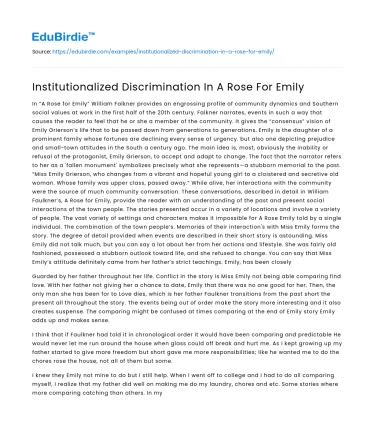Introduction
William Faulkner's short story "A Rose for Emily" is a profound exploration of the Old South's societal dynamics, laden with themes of tradition, change, and decay. One of the most compelling aspects of the narrative is its subtle yet pervasive depiction of institutionalized discrimination. Through the life and experiences of its protagonist, Emily Grierson, Faulkner illustrates the rigid social hierarchies and prejudices that govern the town of Jefferson. The story serves as a microcosm of the broader societal constructs in the American South, where race, gender, and class intertwine to maintain a status quo rooted in historical injustices. This essay delves into how institutionalized discrimination manifests in the story through gender roles, racial dynamics, and class distinctions, offering a critique of the systemic biases that shape individual destinies. By examining these elements, the narrative reveals the complexities of Southern identity and the pervasive impact of entrenched societal norms.
Gender Roles and Patriarchal Constraints
Within "A Rose for Emily," Faulkner constructs a narrative where gender roles are deeply entrenched, reflecting the patriarchal constraints of the early 20th-century South. Emily Grierson's life is dominated by the men around her, from her overbearing father to the townsmen who dictate her social interactions. Her father's control over her life is emblematic of the gender-based power dynamics prevalent in her society. He not only determines her romantic prospects but also isolates her from the community, believing no suitor is worthy of her. This paternal dominance is a clear manifestation of institutionalized gender discrimination, which relegates women to subservient roles under male authority.
Save your time!
We can take care of your essay
- Proper editing and formatting
- Free revision, title page, and bibliography
- Flexible prices and money-back guarantee
Faulkner uses Emily's character to critique the societal norms that confine women within rigid boundaries. Her eventual isolation and descent into madness underscore the destructive impact of such constraints. As Judith Fetterley notes, Emily's "madness" can be interpreted as a rebellion against the oppressive structures that deny her autonomy ("The Resisting Reader," 1978). Moreover, the townspeople's reaction to Emily's relationship with Homer Barron further highlights the gender prejudices of the time. Their gossip and judgment reflect a societal obsession with controlling female sexuality and maintaining traditional gender roles. By portraying Emily as both a victim and a transgressor, Faulkner challenges the patriarchal norms that dominate her life.
Racial Dynamics and Social Hierarchies
In addition to gender, Faulkner's narrative also addresses racial dynamics, illustrating the entrenched racial hierarchies in the Southern society. The character of Tobe, Emily's African American servant, serves as a silent witness to the events of the story, embodying the racial subjugation of the era. His presence in the Grierson household reflects the historical legacy of slavery and the continued exploitation of African Americans, even after emancipation. Tobe's silence throughout the narrative speaks volumes about the systemic racism that renders him invisible and voiceless within the community.
This racial dynamic is further emphasized by the townspeople's attitudes and actions. The community's disregard for Tobe's agency and their expectation of his loyalty to Emily highlight the pervasive racial discrimination that defines social interactions. As critic Cleanth Brooks observes, Tobe's role underscores "the South's reluctance to break free from its racial past" ("William Faulkner: Toward Yoknapatawpha and Beyond," 1978). Faulkner's depiction of these racial hierarchies serves as a critique of the institutionalized racism that permeates Southern society, revealing the deep-seated prejudices that persist despite the changing times.
Class Distinctions and Economic Power
Class distinctions also play a critical role in "A Rose for Emily," with Faulkner highlighting the economic power structures that uphold social hierarchies. The Grierson family's status as Southern aristocracy affords them a certain level of respect and privilege, despite their declining fortune. This social standing allows Emily to act with impunity, as seen in her refusal to pay taxes and her disregard for social conventions. The community's deference to Emily's class is indicative of the institutionalized class discrimination that prioritizes lineage and wealth over individual merit.
The townspeople's fluctuating attitudes towards Emily underscore the complexities of class-based discrimination. While they initially revere the Grierson name, their perception shifts as Emily's eccentricities become more pronounced. This change reflects the tenuous nature of class privilege, which is contingent upon adherence to societal expectations. As John Skinner argues, Faulkner's portrayal of class dynamics "exposes the fragility of social hierarchies that rely on superficial markers of status" ("The Function of Class in Faulkner's Work," 1995). By illustrating the intersection of class with other forms of discrimination, Faulkner critiques the systemic biases that perpetuate social inequalities.
Conclusion
In "A Rose for Emily," William Faulkner weaves a narrative rich with themes of institutionalized discrimination, using the microcosm of Jefferson to explore the broader societal constructs of the South. Through the lens of gender, race, and class, the story reveals the pervasive impact of entrenched biases on individual lives. Faulkner's critique of these systemic injustices highlights the complexities of Southern identity and the challenges of reconciling tradition with change. By portraying characters who are both products and victims of their environment, Faulkner invites readers to reflect on the enduring legacy of discrimination and the necessity of confronting societal norms that perpetuate inequality. Ultimately, "A Rose for Emily" serves as a poignant reminder of the power of literature to illuminate the human condition and provoke critical discourse on issues of social justice.






 Stuck on your essay?
Stuck on your essay?

